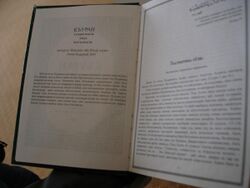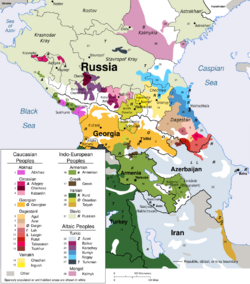Social:Karachay-Balkar language
| Karachay-Balkar | |
|---|---|
| къарачай-малкъар тил таулу тил | |
| Native to | Russia |
| Region | Kabardino-Balkaria, Karachay–Cherkessia, Afyonkarahisar Province, Konya Province, Eskişehir Province, Tokat Province, Kayseri Province, Ankara Province, İstanbul Province, İzmir Province, Antalya Province, Sivas Province |
| Ethnicity | Karachays, Balkars |
Native speakers | 310,000 (2010 census)[1] |
Turkic
| |
| Dialects |
|
| Cyrillic Latin | |
| Official status | |
Official language in |
|
| Language codes | |
| ISO 639-1 | krc |
| ISO 639-3 | krc |
| Glottolog | kara1465[2] |
The Karachay-Balkar language (Къарачай-Малкъар тил, Qaraçay-Malqar til or Таулу тил, Tawlu til) is a Turkic language spoken by the Karachays and Balkars in Kabardino-Balkaria and Karachay–Cherkessia, European Russia, as well as by an immigrant population in Afyonkarahisar Province, Turkey. It is divided into two dialects: Karachay-Baksan-Chegem, which pronounces two phonemes as /tʃ/ and /dʒ/ and Malkar, which pronounces the corresponding phonemes as /ts/ and /z/. The modern Karachay-Balkar written language is based on the Karachay-Baksan-Chegem dialect. The language is closely related to Kumyk.[3]
Writing
Historically, the Arabic Alphabet had been used by first writers until 1924. Handwritten manuscripts of the Balkar poet Kazim Mechiev and other examples of literature have preserved to this day. First printed books in Karachay-Balkar language were published In the beginning of 20th century.
After the October Revolution as part of a state campaign of Latinisation Karachay and Balkar educators developed a new alphabet based on Latin letters. In 1930s, the official Soviet policy was revised and the process of Cyrillization the languages of USSR peoples was started. In 1937–38 the new alphabet based on Cyrillic letters was officially adopted.
Alphabet
Modern Karachay-Balkar Cyrillic alphabet:
| А а /a/ |
Б б /b/ |
В в /v/ |
Г г /g/ |
Гъ гъ |
Д д /d/ |
Дж дж /dʒ/ |
Е е /je/ |
| Ё ё /ø, jo/ |
Ж ж** /ʒ/ |
З з /z/ |
И и /i/ |
Й й /j/ |
К к /k/ |
Къ къ /q/ |
Л л /l/ |
| М м /m/ |
Н н /n/ |
Нг нг /ŋ/ |
О о /o/ |
П п /p/ |
Р р /r/ |
С с /s/ |
Т т /t/ |
| У у /u, w/ |
Ф ф* /f/ |
Х х /x/ |
Ц ц /ts/ |
Ч ч /tʃ/ |
Ш ш /ʃ/ |
Щ щ | |
| ъ |
Ы ы /ɯ/ |
ь |
Э э /e/ |
Ю ю /y, ju/ |
Я я /ja/ |
- * Not found in native vocabulary
- ** Found in native vocabulary when only part of a digraph, or else it is not found natively
Karachay-Balkar Latin alphabet:
| A a | B в | C c | Ç ç | D d | E e | F f | G g |
| Ƣ ƣ | I i | J j | K k | Q q | L l | M m | N n |
| N̡ n̡ | O o | Ө ө | P p | R r | S s | Ş ş | T t |
| Ь ь | U u | V v | Y y | X x | Z z | Ƶ ƶ |
Phonology
| Front | Back | |
|---|---|---|
| Close | i y | ɯ u |
| Mid | e ø | o |
| Open | a |
| Labial | Alveolar | Palatal | Velar | Uvular | Glottal | |
|---|---|---|---|---|---|---|
| Plosive | p b | t d | k ɡ | (q) (ɢ) | ||
| Fricative | [f] | s z | ʃ | x (ɣ) | h | |
| Affricate | [ts] | tʃ dʒ | ||||
| Nasal | m | n | ŋ | |||
| Liquid | l r | |||||
| Approximant | w | j |
Parentheses indicate allophones.
Grammar
Nominals
Cases
| Case | Suffix |
|---|---|
| Nominative | -ø |
| Accusative | -NI |
| Genitive | -NI |
| Dative | -GA |
| Locative | -DA |
| Ablative | -DAн |
Possessive suffixes
| 1st person | 2nd person | 3rd person | |
|---|---|---|---|
| Singular | -Iм | -Iнг | -(s)I(n) |
| Plural | -IбIз | -IгIз | -(s)I(n) |
Language example
Article 1 of the Universal Declaration of Human Rights in Karachay-Balkar:
| In Cyrillic | Transliteration | Translation |
| Бютеу адамла эркин болуб эмда сыйлары бла хакълары тенг болуб тууадыла. Алагъа акъыл бла намыс берилгенди эмда бир-бирлерине къарнашлыкъ халда къараргъа керекдиле. | Bütew adamla erkin bolub emda sıyları bla haqları teñ bolub tuwadıla. Alağa aqıl bla namıs berilgendi emda bir-birlerine qarnaşlıq halda qararğa kerekdile. | All human beings are born free and equal in dignity and rights. They are endowed with reason and conscience and should act towards one another in a spirit of brotherhood. |
Numerals
| Numeral | Karachay-Balkar | Kumyk | Nogay |
|---|---|---|---|
| 0 | ноль | ноль | ноль |
| 1 | бир | бир | бир |
| 2 | эки | эки | эки |
| 3 | юч | уьч | уьш |
| 4 | тёрт | дёрт | доьрт |
| 5 | беш | беш | бес |
| 6 | алты | алты | алты |
| 7 | джети | етти | йети |
| 8 | сегиз | сегиз | сегиз |
| 9 | тогъуз | тогъуз | тогыз |
| 10 | он | он | он |
Loanwords
Loanwords from Ossetian, Kabardian, Arabic, and Persian are fairly numerous.[3]
Bibliography
- Chodiyor Doniyorov and Saodat Doniyorova. Parlons Karatchay-Balkar. Paris: Harmattan, 2005. ISBN:2-7475-9577-3.
- Steve Seegmiller (1996) Karachay (LINCOM)
References
- ↑ Row 102 in "Error: no
|title=specified when using {{Cite web}}" (in Russian) (XLS). Федеральная служба государственной статистики [Federal State Statistics Service]. http://www.gks.ru/free_doc/new_site/population/demo/per-itog/tab6.xls. - ↑ Hammarström, Harald; Forkel, Robert; Haspelmath, Martin, eds (2017). "Karachay-Balkar". Glottolog 3.0. Jena, Germany: Max Planck Institute for the Science of Human History. http://glottolog.org/resource/languoid/id/kara1465.
- ↑ 3.0 3.1 George L. Campbell and Gareth King (2013). Compendium of the World Languages. Routledge. ISBN 978-1-1362-5846-6. https://books.google.com/books?id=DWAqAAAAQBAJ&pg=PA832. Retrieved 23 May 2014.
- ↑ 4.0 4.1 Seegmiller, Steve. Phonological and Orthographical Information in Dictionaries: The Case of Pröhle's Karachay Glossary and its Successors.
External links
| къарачай-малкъар edition of Wikipedia, the free encyclopedia |
| Wikivoyage has a travel guide for Karachay-Balkar phrasebook. |
- Russian-Karachay-Balkar On-Line Dictionary (a)
- Russian-Karachay-Balkar On-Line Dictionary (b)
- "Заман" newspaper
- "Къарачай" newspaper
- "Минги Тау" magazine



